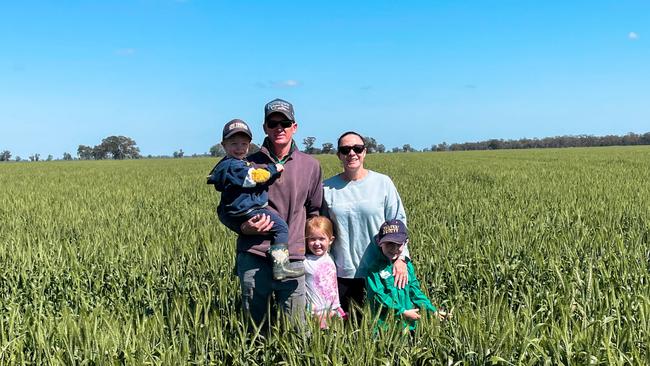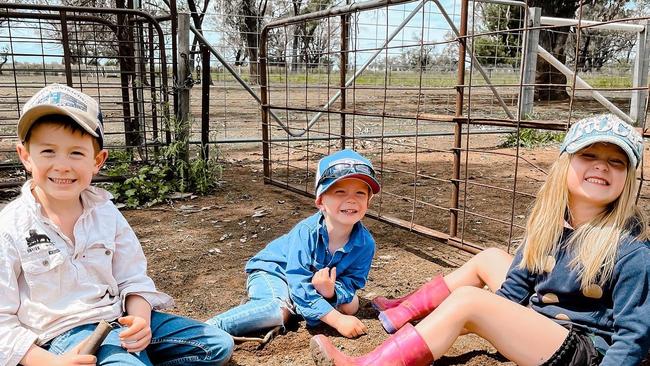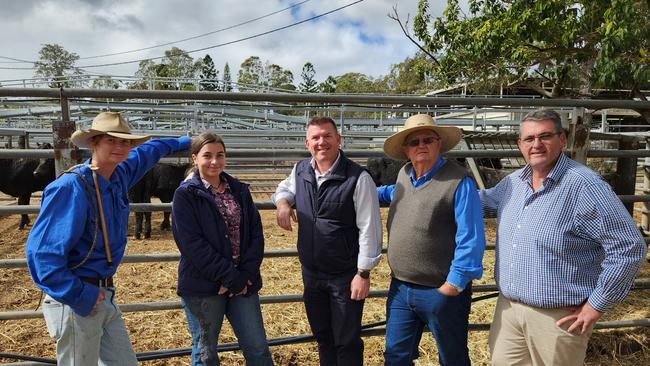Farmers are sacrificing their own health for their livestock and crop as a dramatic reduction in rainfall this winter season sees communities across the state’s central west and north scrambling to “drought-proof” their land.
Rural Aid is working to deliver water tank refills to ensure farmers have accessible and clean drinking water on their properties, as calls for help skyrocket.
In the past year, the charity has seen a 250 per cent increase in demand, with 29 tank deliveries in July and 21 in June, 2023, compared to six requests in June last year.
Rural Aid CEO John Warlters told The Daily Telegraph 49 deliveries to the state’s central west have been made in August so far, with more expected towards the end of the month.

Tanks contain an estimated 20,000 litres of water and will last a family around a month.
“Money gets tight very quickly, especially if people are feeding livestock, so if we can assist them to not have to worry about the finances of water then it takes a huge weight off people’s shoulders,” Mr Warlters said.
“We can’t underestimate how stressful farming can be for families when you throw in all of those variables and all of the issues they have to deal with on a day-to-day basis, let alone the normal life stuff.”
Collie cattle and crop farmer Julia Jeffery said her family moved to The Warren Shire in 2016 - just before the drought.

“We went from a house that was run on rainwater to a house that was run on bore water,” Ms Jeffery said.
She said during the drought, the family relied on bore water for daily necessities but needed to purchase drinking water to sustain themselves.
Ms Jeffery said during the drought Rural Aid provided the family with hay to feed their livestock but supplied them a tank earlier this year for “better quality water”.

“As we’re potentially coming into another drought, it’s assuring to know that we will have clean and freshwater, so we won’t be relying on the bore too much and buying drinking water,” she said.
“We’ll save a lot of money and I guess we won’t need to go into town so much - it’s not that easy, it’s 40 minutes away - so when we run out of water, it’s a long trip.
“Having people from Rural Aid contact us and reach out meant a lot to us, we’re not generational farmers so it is nice to have that support.
“Obviously now we have put ourselves in a position where we see that drought is on the rise so we’re trying to droughtproof our farm, but we didn’t have that opportunity when we first purchased the land.”

Dubbo cattle farmer Win Mumford received a tank earlier this year, giving her the reassurance of having accessible drinking water.
“I thank them a lot because at the end of the day, it’s water, and it is a genuine help,” Ms Mumford said.
In the state’s northern rivers, large parts of the Clarence Valley and Richmond Valley have already been declared drought affected — or in some cases, in drought — by the Department of Primary Industries (DPI).
It’s a cruel blow for farmers who are still recovering from the catastrophic 2022 floods and now find themselves having to make tough decisions after a failure of autumn and winter rainfall to materialise.
Peter Baldwin, the chief executive officer of the Australian Livestock and Property Agents Association, said cattle farmers are being left to make difficult decisions.
“With the dry weather looking more likely, compounded by the sharp falls in cattle prices, livestock producers are making adjustments to their stocking rates to figure out how to get enough feed to get through the next few months”, Mr Baldwin said.
“The most important thing for producers right now is to have a clear plan and to know they have support around them to face the difficult times ahead.”
North Coast Local Land Services livestock officer Nathan Jennings said while the situation is different for every farmer in the Clarence and Richmond Valleys, many will be left facing difficult decisions.

“As a hangover from (the floods) last year, our pastures really copped a bit of a hammering, and then from January on the rain all but turned off and the farmers just haven’t had the opportunity to recover,” he said.
“And now we probably have only 20 per cent of the pasture we would normally have around for August.”
Mr Jennings attributed this to three central factors: a dry, late summer and autumn; some early frost which stopped tropical pasture growth; and the ongoing effects of the 2022 floods which damaged a lot of pasture.
“It does seem funny because it was so wet last year,” he said.
“But that flooding severely damaged or killed a lot a pasture in the low-lying flood plain areas and that meant people had stock on higher country.
“And they’ve now taken a bit of beating because of that because the hills and those higher areas were the drier areas of farms.”
He advised each farmer to seriously assess their own situation and “be realistic” about how much stock they could keep, adding that the cost of stock feed is currently at record levels.

While local cattle farmers are facing tough decisions, blame is being flung around from both sides of the political aisle.
Nationals Leader Dugald Saunders and Clarence state Nationals MP Richie Williamson called for more support.
“The last drought was the worst in living memory and it is vital that we plan for the next one now,” Mr Saunders said.
While Mr Williamson said his region needs certainty with drought already on the doorstep.
“It is hard to believe that as our community tries to recover from catastrophic floods, some areas are already facing dry weather patterns,” Mr Williamson said.
“It is more important now than ever that Labor steps up to help our primary producers because they have faced so much and shouldn’t have to go it alone.”
Mr Saunders also used his speech at this year’s NSW Farmers Conference to raise the issue, highlighting the need for the Government to roll out another round of the Coalition’s previous Farm Innovation Fund.
“The key message here is that prevention is better than a cure and the Farm Innovation Fund is the single biggest opportunity farmers have to prepare for hardship and to remain resilient,” Mr Saunders said.

Water and North Coast Minister Rose Jackson confirmed the NSW Labor Government is currently working on programs to assist farmers.
“With another drought now knocking on our door it’s clear there’s more to be done to prepare NSW,” Ms Jackson said.
“To be clear, the inaction and neglect from the former government has put us in this position.
“Had they been more proactive in preparing our state to face the looming drought, but unfortunately there was a lot left to be desired.”
She added the state is now in a situation where “hundreds of towns” are on extreme water security and water quality risk ratings.
“We are working on improving our drought resilience across the state through leak detection programs, drought management plans for regulated rural valleys … and investment for crucial infrastructure to shore up water security for communities,” Ms Jackson added.
“This is just the start, we have so much more to do to ensure we’re supporting regional communities.”

Add your comment to this story
To join the conversation, please log in. Don't have an account? Register
Join the conversation, you are commenting as Logout
NRRRL: Newcomers eye off fairytale finals charge
One side has snapped a 330-day drought in spectacular fashion while the competition newcomers have stormed into the top six in the NRRRL.
Fisherman who drowned is buried beside his son
The wife of a keen fisherman who disappeared while on a trip to Boondooma Dam has reached out to the community following the five-day search that ended in the tragic discovery of his body.